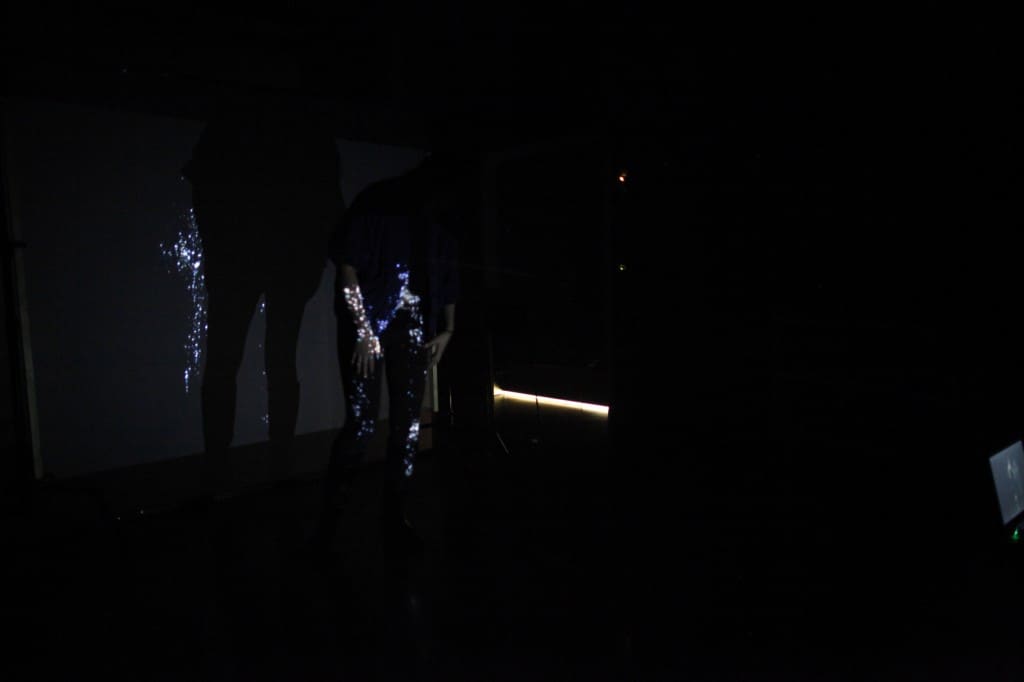 After completing the screen-tests, I had an idea of what type of visual language to use. Before I continued developing the software, I tested the stating images but without a screen this time. I projected them at the participant’s body directly.
After completing the screen-tests, I had an idea of what type of visual language to use. Before I continued developing the software, I tested the stating images but without a screen this time. I projected them at the participant’s body directly.
When I did this, I noticed something very important for the whole experience. the idea was to have the stardust on your body, with no screens anywhere. But, as a participant, you do want to see how they look: I needed a way to document how it looked like and show it back to the people experiencing the installation. I used real mirrors to do so.
In this way, the main system would work with embodiment, and you had to experience stardust on you, yet the project would also include the perception of your body image, but not through a screen; it would be through a real mirror instead.
 Test projecting a stardust demo on the participant’s body.
Test projecting a stardust demo on the participant’s body.
 Without a mirror, he can only see partially how Stardust looks.
Without a mirror, he can only see partially how Stardust looks.
 Projecting on the participant’s body.
Projecting on the participant’s body.
 Projecting stardust. A different experience once the participant can see his own body in full-scale with the stardust on.
Projecting stardust. A different experience once the participant can see his own body in full-scale with the stardust on.
 Projecting on the participant’s body with a mirror next to her as part of the installation test.
Projecting on the participant’s body with a mirror next to her as part of the installation test.
 Projector and participant’s reflection.
Projector and participant’s reflection.
 Detail of reflection in the mirror.
Detail of reflection in the mirror.
With a mirror to look at yourself, the experience was enhanced for the participants. After these tests, I sketched out ideas of how to use the mirrors in the final setup. It was tricky to work with the feed from the kinect, align that to the projector (I wanted the projected stars on the person’s silhouette) and figure out where the mirror would be placed.
I came up with 3 options for the final setup.
1. The mirror would be a one-way mirror (like the ones used in focus groups or interrogations with the cops). Using this type of material, you could look at your own reflection, yet (I thought) the light coming from the projector could go through the mirror and on to the body; source of light and documentation device (mirror) would be perfectly aligned.
 I remembered the “one way mirror” thing from an old psychology class where the teacher explained “La cámara Gesell”, or the Gesell dome, used to study children without them being aware they were being watched.
I remembered the “one way mirror” thing from an old psychology class where the teacher explained “La cámara Gesell”, or the Gesell dome, used to study children without them being aware they were being watched.
 Sketch of option 1: one-way mirror with the kinect and projector behind it.
Sketch of option 1: one-way mirror with the kinect and projector behind it.
Result…
 …a prominent hot-spot in the center of he one-way mirror (in this case, I used a model as prototype, and tinted sunglasses as one-way mirror). Not only the light, but also the heat from the projector also contributed to the hot spot. Time to try the next option.
…a prominent hot-spot in the center of he one-way mirror (in this case, I used a model as prototype, and tinted sunglasses as one-way mirror). Not only the light, but also the heat from the projector also contributed to the hot spot. Time to try the next option.
2. A paper-foil mirror-like material. This way, the kinect would be hidden behind it and register the participant, while the projector would be behind the people, at an angle in order for the stardust to be reflected by the paper-like mirror. The reason for it to be paper, is so that it can be paper thin, and thus, easier for the kinect to sense through it.
 Sketch of option 2: paper-like mirror material. The result…
Sketch of option 2: paper-like mirror material. The result…
 Testing out the prototype proved that the paper did not reflect the stardust back. The material did not have the qualities of a real mirror… so I chose option 3.
Testing out the prototype proved that the paper did not reflect the stardust back. The material did not have the qualities of a real mirror… so I chose option 3.
3. Use a real mirror, and figure out a way to incorporate it in the final installation.
 Sketch of a real mirror (kinect hidden behind). The result of just the function of reflecting the stars (no kinect yet)…
Sketch of a real mirror (kinect hidden behind). The result of just the function of reflecting the stars (no kinect yet)…
 It worked! It reflected the stardust back into the model. When the final installation is set-up the trick would be to see 1) if the kinect picks up the user in front of the mirror and if not, how to integrate it into the installation in a practical way.
It worked! It reflected the stardust back into the model. When the final installation is set-up the trick would be to see 1) if the kinect picks up the user in front of the mirror and if not, how to integrate it into the installation in a practical way.
The next step then, was to develop the visual language of Stardust. I used the image selected by the participants as a starting point (the yellow-golden particle reference image).



